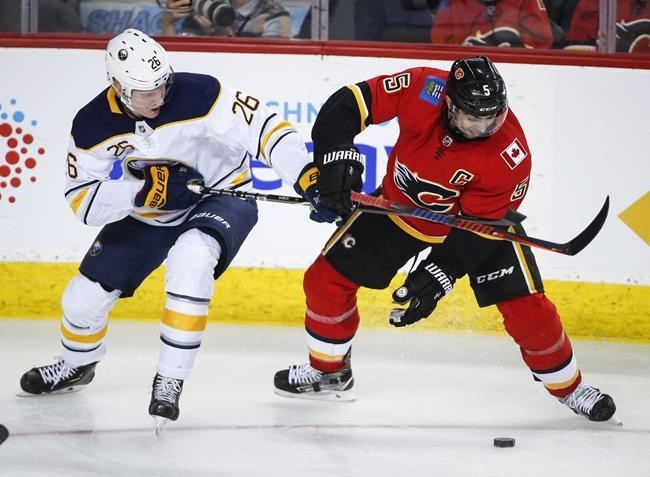Mark Giordano and John Tavares are keen to see what player and puck tracking brings to the NHL.
They're just not exactly sure how all the data — the new technology is expected to provide as many as 10,000 statistical categories compared to the hundreds the league now has — will impact the on-ice product, if at all.
"A lot of analytics have come into the game in recent years, but I still believe you really have to watch the game and the eye test is the best one," said Giordano, captain of the Calgary Flames. "Hockey is a game of things that happen randomly and there's reactions and all that sort of stuff.
"So many random things can happen in hockey. Weird goals, weird plays. You have to watch the game."
The NHL tested its tracking systems in the regular season for the first time earlier this month, and will showcase the technology at this weekend's all-star game in San Jose.
The technology — which uses microchips fitted to players' shoulder pads and placed inside specially designed pucks tracked via radio frequencies — could be implemented in all 31 NHL arenas as early as next season.
The league hopes it will improve the experience for fans, broadcasters and gamblers. There's potential opportunities for virtual reality and in-game wagering.
"For fans and for viewership, I think it'll give some great insight on what makes us hockey players great athletes and different athletes — the things we can do at high speeds and in fractions of seconds," said Tavares, a centre for the Toronto Maple Leafs.
But when it comes to players and coaches, Tavares isn't convinced tracking will change much.
"You've got to have perspective on a lot of things," he said. "There's still something about the game being very instinctive — reading the play, understanding the game, anticipation, awareness."
Leafs winger Patrick Marleau, who is in his 21st NHL season, said player and puck tracking is just part of the natural progression of technology meshing with sports.
"I can see how as a fan you would be interested," he said. "Everybody these days is information-hungry, so it's a good way to play into it.
"You can lose a lot things when you just look at numbers. There's a lot more intangibles, but I think they have their place."
Vancouver Canucks head coach Travis Green said it's important to prioritize data that actually means something.
"I'd be interested to see what they have, what analytics they're talking about bringing to the forefront," he said. "But we have access to a lot of information. Some analytics I like and some I don't put as much stock in.
"I don't coach off analytics ... but we use it and take part in it and make judgments."
Some of the information available could include the distance a player skates in a game, but Giordano cautioned that while interesting, a stat of that nature will never paint a full picture.
"Some guys are way more efficient skaters than others," Giordano said. "Some guys play a smarter, more positionally-sound game so they won't skate as much as other guys. You've got to really look at the player and really watch them play to know how good of a player they are."
"Who's had the more effective game or is it just the role they're playing?" Tavares added when it comes to the amount of ice covered. "The game can be played many different ways. Players see it all different ways. There's a uniqueness to that.
"There's part of it that you can't really measure."
Other possibilities could include how fast a player skates, the hardest shot in a game, and for specific gambling purposes, betting on where the next goal will come from on the ice and where it ends up in the net — such as top left corner, bottom right or five-hole.
But perhaps Leafs centre Nazem Kadri said it best — the new technology in the end won't be so much for the players and teams.
It's meant primarily for everyone else.
"It's good for the growth of the game," he said. "They want to try to get people watching hockey with the gambling thing and bringing that whole thing together and creating more revenue. If people have money on the games, that means they'll pay closer attention.
"For the most part, we have all the data we need."
HIGH-FLYING FLAMES
Calgary's 3-2 overtime victory against Carolina on Tuesday pushed the Flames to 71 points in 51 games. The only other time Calgary reached the 70-point mark sooner — 70 in 50 games — was back in 1988-89 when the Flames won their only Stanley Cup.
GOAL BINGE CONTINUES
San Jose and Washington combined to score 13 times in the Sharks' overtime victory Tuesday, the 15th game across the league with at least 12 goals this season. That's the highest total up to this point in the schedule since the 1995-96 campaign.
COYOTES CLIMBING
Arizona goalie Darcy Kuemper is 6-0-2 since Jan. 1 as the Coyotes continue to creep up the standings. The club, which has dealt with a slew of injuries to key players, is 6-1-1 in its last seven and sat just two points back of both wild-card spots in the Western Conference following Tuesday's 3-2 victory in Ottawa.
___
With files from Donna Spencer in Calgary and Gemma Karstens-Smith in Vancouver
Follow @JClipperton_CP on Twitter
Joshua Clipperton's weekly NHL notebook is published every Wednesday
Joshua Clipperton, The Canadian Press


